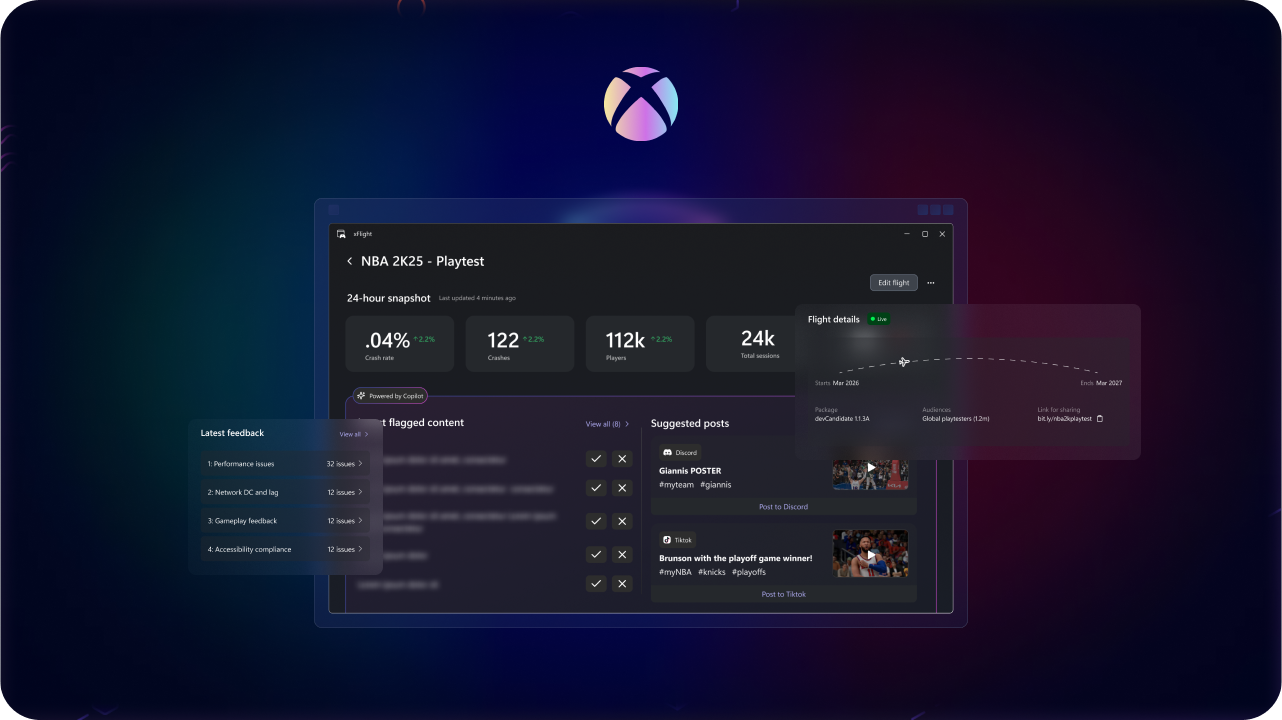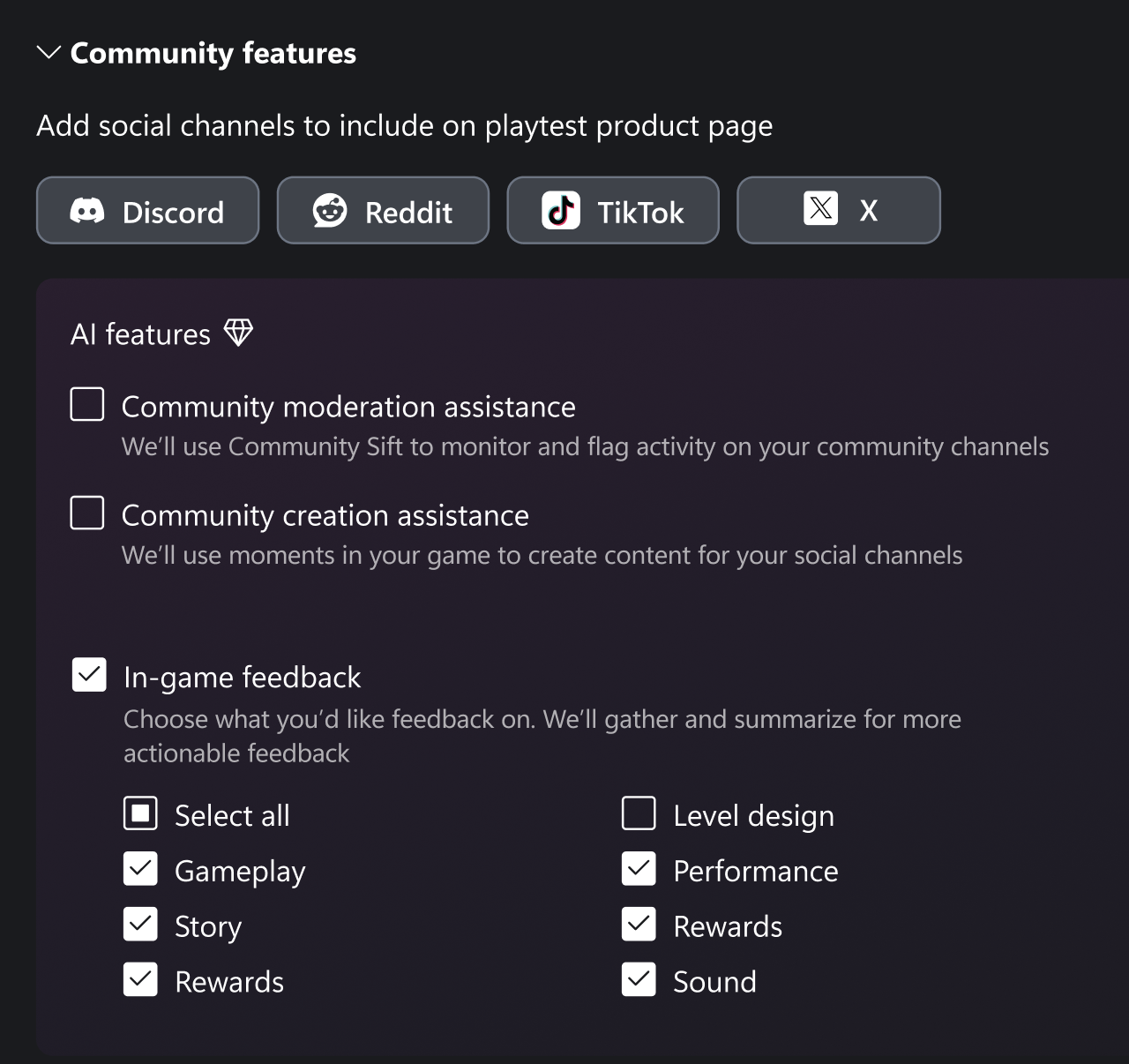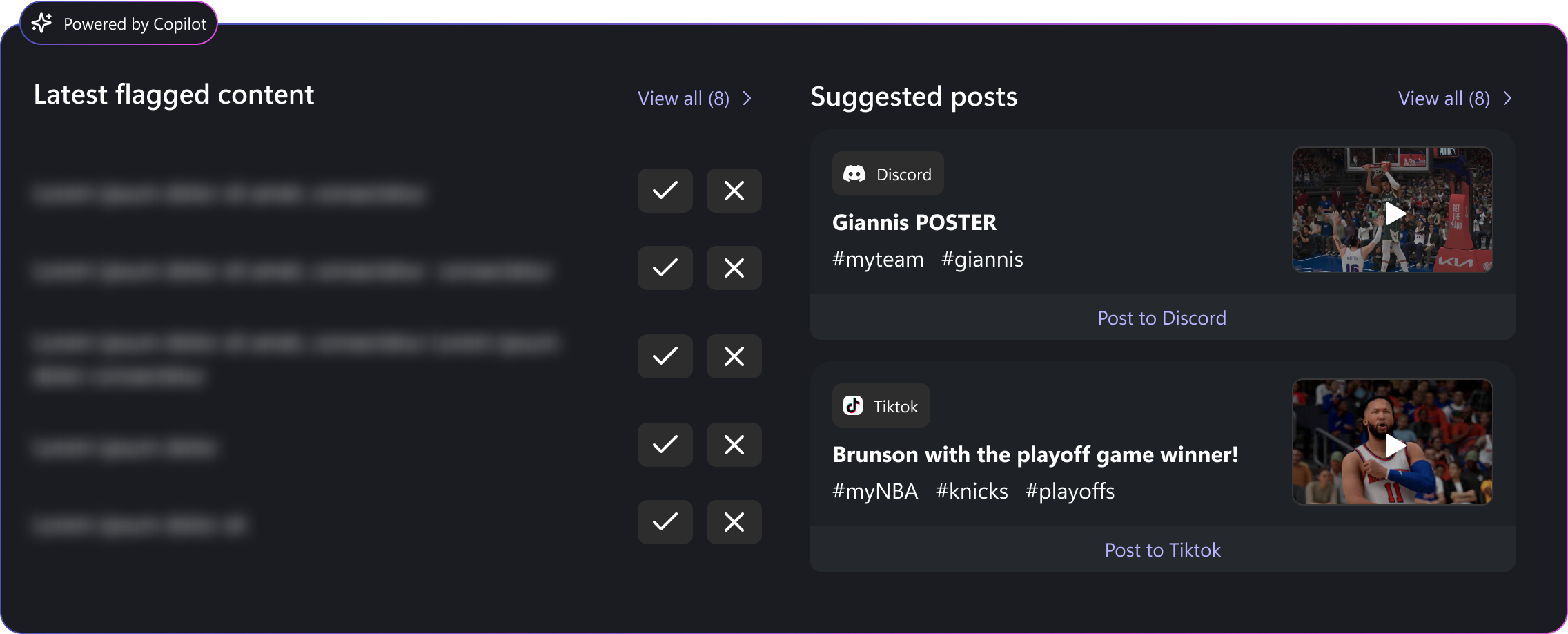Created with beta software, there may be some bugs

Tighter feedback loops between gamers and studios
We added game flighting capabilities to Microsoft Partner Center and a new packaging tool to help game studios test pre-released games and build a community around those games.
Role: Product design lead
Goal
Create a unified, flexible experience for game creators and studio managers to manage their flighting processes and audiences. And by extension, help creators build their community through playtesting pre- and post-release games.
Challenges
Integrating new experiences with existing ones typically comes with few challenges.
- Technical constraints need to be addressed; the pre-existing infrastructure should be flexible enough to avoid creating a disjointed solution.
- Collaboration between teams can also be problematic, as differences in culture, strategic roadmaps, and resource capacity might lead to a misalignment in vision.
- Institutional knowledge can be a double-edged sword; it’s necessary to engage with folks who are open-minded and curious rather than resistant to change or entrenched in their ways of doing things. But luckily, I encountered the former and not the latter.
How I worked
We started by doing an onsite, which is something I’d like to do more of in the future. It was great to have everybody in a room focused on a single goal for an extended amount of time. Usually, our attention is fractured or we don’t get the necessary time to ask questions and make decisions during brief kickoff meetings. Due to an organization shift, I was invited to the onsite the day before and knew nothing about flighting/playtesting. But because of the format, by the end of the last day, I had a clear path forward for 90% of it, and I knew who to go to for the remaining 10%.
The team came with a trove of research, thanks to our wonderful research team. Flighting is an effort that has come up in one way or another but never got over the finish line. I suspect because there were lots of other things going on at the same time and never had this amount of focused, dedicated resources.
I needed to know everything there was to know about playtesting and flighting, so I started with a bunch of informational meetings and ended up learning a ton over that first week:
- I met with the researcher to hear directly what customers have been asking for (easier Audience creation & tighter connection with playtesters).
- I met with the PMs that had worked on similar projects.
- I met with other designers that had done some thinking around the creator/player feedback system.
We don’t work in a traditional PM-gives-designers-tasks model, so I needed to build out my own bucket of tasks for this project. I took a user-centric approach and asked myself, “based on our goals for this project, what exactly does a creator need to be able to do?” I also try to think screen-by-screen when setting these tasks up, as not to get too overwhelmed with the amount of work that needs to be done. So things as small as needing to end a flight from different places in the product needed to be taken into account.
I ran weekly design syncs with all the stakeholders. We also worked well asynchronously. I sent designs early and often, every other day once I was getting feedback from someone, whether it was PM, my design team or engineering. I also had close collaboration with our PMs in India. At times with teams in India, it sometimes requires an early morning or a late night. I designed far and wide. I started near-term -- what we could deliver in a few months -- and as I learned more and more, went wider to design concepts a couple years out. During our Hack Week, I took the time to think 2-3 years out and designed some community features that were well received and could actually be built using existing technology.
This was also my first time designing for the Xbox console and any future, unreleased surfaces. So collaborating with the console team was necessary as well.
I ended up breaking this project up into three phases: Phase 1 would give creators that use Microsoft Partner Center the ability to easily create and manage a flight and players the ability to discover and install said flight. Phase 2 would include this functionality in a new Package tool I designed and was helping launch. (each of these products serves a different user base). Phase 3 would add on some community and AI features that would help creators build their community around their playtests.

Community & AI features
Creators can leverage AI to help build their community

Creator dashboard
Creators can post AI-generated posts to their community and moderate comments straight from their dashboard
Outcome
Before it launched, the lead technical PM, as an advocate for design and craft, helped drive an engineering effort around getting what was built closer to my designs. I had noticed a handful of instances during a demo where the design just wasn’t right. So I’m happy we were able to get that done.
We then launched the ability to create a flight to a small group of game studios to play with and test. The results were largely positive. Most of the feedback was on the technical side. There were some questions about more robust audience creation during flight creation. Some larger studios will need that ability so that’s being built in. Once that’s done, we’ll go back to the same group of studios and keep a tight feedback loop going with them. Phase 2 is designed and slated for completion by the end of 2025. Phase 3 is TBD and hinges on the previous phase completion.
Created with beta software, there may be some bugs

Tighter feedback loops between gamers and studios
We added game flighting capabilities to Microsoft Partner Center and a new packaging tool to help game studios test pre-released games and build a community around those games.
Role: Product design lead
Goal
Create a unified, flexible experience for game creators and studio managers to manage their flighting processes and audiences. And by extension, help creators build their community through playtesting pre- and post-release games.
Challenges
Integrating new experiences with existing ones typically comes with few challenges.
- Technical constraints need to be addressed; the pre-existing infrastructure should be flexible enough to avoid creating a disjointed solution.
- Collaboration between teams can also be problematic, as differences in culture, strategic roadmaps, and resource capacity might lead to a misalignment in vision.
- Institutional knowledge can be a double-edged sword; it’s necessary to engage with folks who are open-minded and curious rather than resistant to change or entrenched in their ways of doing things. But luckily, I encountered the former and not the latter.
How I worked
We started by doing an onsite, which is something I’d like to do more of in the future. It was great to have everybody in a room focused on a single goal for an extended amount of time. Usually, our attention is fractured or we don’t get the necessary time to ask questions and make decisions during brief kickoff meetings. Due to an organization shift, I was invited to the onsite the day before and knew nothing about flighting/playtesting. But because of the format, by the end of the last day, I had a clear path forward for 90% of it, and I knew who to go to for the remaining 10%.
The team came with a trove of research, thanks to our wonderful research team. Flighting is an effort that has come up in one way or another but never got over the finish line. I suspect because there were lots of other things going on at the same time and never had this amount of focused, dedicated resources.
I needed to know everything there was to know about playtesting and flighting, so I started with a bunch of informational meetings and ended up learning a ton over that first week:
- I met with the researcher to hear directly what customers have been asking for (easier Audience creation & tighter connection with playtesters).
- I met with the PMs that had worked on similar projects.
- I met with other designers that had done some thinking around the creator/player feedback system.
We don’t work in a traditional PM-gives-designers-tasks model, so I needed to build out my own bucket of tasks for this project. I took a user-centric approach and asked myself, “based on our goals for this project, what exactly does a creator need to be able to do?” I also try to think screen-by-screen when setting these tasks up, as not to get too overwhelmed with the amount of work that needs to be done. So things as small as needing to end a flight from different places in the product needed to be taken into account.
I ran weekly design syncs with all the stakeholders. We also worked well asynchronously. I sent designs early and often, every other day once I was getting feedback from someone, whether it was PM, my design team or engineering. I also had close collaboration with our PMs in India. At times with teams in India, it sometimes requires an early morning or a late night. I designed far and wide. I started near-term -- what we could deliver in a few months -- and as I learned more and more, went wider to design concepts a couple years out. During our Hack Week, I took the time to think 2-3 years out and designed some community features that were well received and could actually be built using existing technology.
This was also my first time designing for the Xbox console and any future, unreleased surfaces. So collaborating with the console team was necessary as well.
I ended up breaking this project up into three phases: Phase 1 would give creators that use Microsoft Partner Center the ability to easily create and manage a flight and players the ability to discover and install said flight. Phase 2 would include this functionality in a new Package tool I designed and was helping launch. (each of these products serves a different user base). Phase 3 would add on some community and AI features that would help creators build their community around their playtests.

Community & AI features
Creators can leverage AI to help build their community

Creator dashboard
Creators can post AI-generated posts to their community and moderate comments straight from their dashboard
Outcome
Before it launched, the lead technical PM, as an advocate for design and craft, helped drive an engineering effort around getting what was built closer to my designs. I had noticed a handful of instances during a demo where the design just wasn’t right. So I’m happy we were able to get that done.
We then launched the ability to create a flight to a small group of game studios to play with and test. The results were largely positive. Most of the feedback was on the technical side. There were some questions about more robust audience creation during flight creation. Some larger studios will need that ability so that’s being built in. Once that’s done, we’ll go back to the same group of studios and keep a tight feedback loop going with them. Phase 2 is designed and slated for completion by the end of 2025. Phase 3 is TBD and hinges on the previous phase completion.